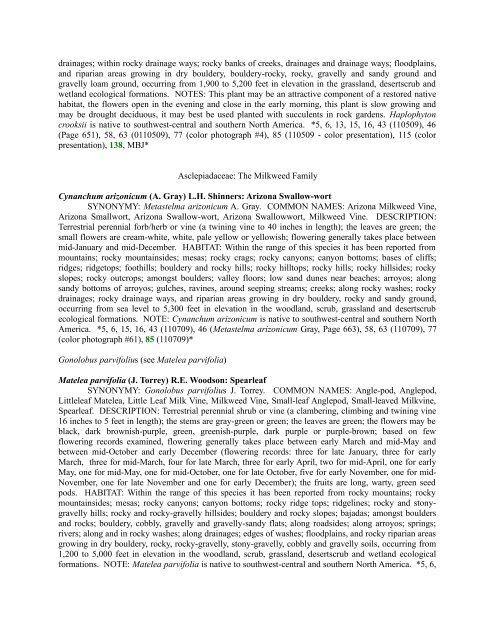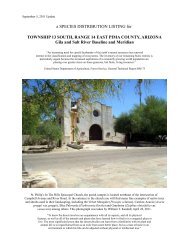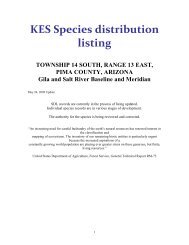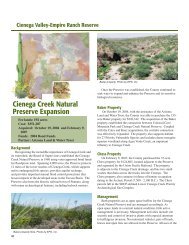Le Jardin de Mère Nature dans une Petite Planète - Pima County
Le Jardin de Mère Nature dans une Petite Planète - Pima County
Le Jardin de Mère Nature dans une Petite Planète - Pima County
Create successful ePaper yourself
Turn your PDF publications into a flip-book with our unique Google optimized e-Paper software.
drainages; within rocky drainage ways; rocky banks of creeks, drainages and drainage ways; floodplains,<br />
and riparian areas growing in dry boul<strong>de</strong>ry, boul<strong>de</strong>ry-rocky, rocky, gravelly and sandy ground and<br />
gravelly loam ground, occurring from 1,900 to 5,200 feet in elevation in the grassland, <strong>de</strong>sertscrub and<br />
wetland ecological formations. NOTES: This plant may be an attractive component of a restored native<br />
habitat, the flowers open in the evening and close in the early morning, this plant is slow growing and<br />
may be drought <strong>de</strong>ciduous, it may best be used planted with succulents in rock gar<strong>de</strong>ns. Haplophyton<br />
crooksii is native to southwest-central and southern North America. *5, 6, 13, 15, 16, 43 (110509), 46<br />
(Page 651), 58, 63 (0110509), 77 (color photograph #4), 85 (110509 - color presentation), 115 (color<br />
presentation), 138, MBJ*<br />
Asclepiadaceae: The Milkweed Family<br />
Cynanchum arizonicum (A. Gray) L.H. Shinners: Arizona Swallow-wort<br />
SYNONYMY: Metastelma arizonicum A. Gray. COMMON NAMES: Arizona Milkweed Vine,<br />
Arizona Smallwort, Arizona Swallow-wort, Arizona Swallowwort, Milkweed Vine. DESCRIPTION:<br />
Terrestrial perennial forb/herb or vine (a twining vine to 40 inches in length); the leaves are green; the<br />
small flowers are cream-white, white, pale yellow or yellowish; flowering generally takes place between<br />
mid-January and mid-December. HABITAT: Within the range of this species it has been reported from<br />
mountains; rocky mountainsi<strong>de</strong>s; mesas; rocky crags; rocky canyons; canyon bottoms; bases of cliffs;<br />
ridges; ridgetops; foothills; boul<strong>de</strong>ry and rocky hills; rocky hilltops; rocky hills; rocky hillsi<strong>de</strong>s; rocky<br />
slopes; rocky outcrops; amongst boul<strong>de</strong>rs; valley floors; low sand d<strong>une</strong>s near beaches; arroyos; along<br />
sandy bottoms of arroyos; gulches, ravines, around seeping streams; creeks; along rocky washes; rocky<br />
drainages; rocky drainage ways, and riparian areas growing in dry boul<strong>de</strong>ry, rocky and sandy ground,<br />
occurring from sea level to 5,300 feet in elevation in the woodland, scrub, grassland and <strong>de</strong>sertscrub<br />
ecological formations. NOTE: Cynanchum arizonicum is native to southwest-central and southern North<br />
America. *5, 6, 15, 16, 43 (110709), 46 (Metastelma arizonicum Gray, Page 663), 58, 63 (110709), 77<br />
(color photograph #61), 85 (110709)*<br />
Gonolobus parvifolius (see Matelea parvifolia)<br />
Matelea parvifolia (J. Torrey) R.E. Woodson: Spearleaf<br />
SYNONYMY: Gonolobus parvifolius J. Torrey. COMMON NAMES: Angle-pod, Anglepod,<br />
Littleleaf Matelea, Little <strong>Le</strong>af Milk Vine, Milkweed Vine, Small-leaf Anglepod, Small-leaved Milkvine,<br />
Spearleaf. DESCRIPTION: Terrestrial perennial shrub or vine (a clambering, climbing and twining vine<br />
16 inches to 5 feet in length); the stems are gray-green or green; the leaves are green; the flowers may be<br />
black, dark brownish-purple, green, greenish-purple, dark purple or purple-brown; based on few<br />
flowering records examined, flowering generally takes place between early March and mid-May and<br />
between mid-October and early December (flowering records: three for late January, three for early<br />
March, three for mid-March, four for late March, three for early April, two for mid-April, one for early<br />
May, one for mid-May, one for mid-October, one for late October, five for early November, one for mid-<br />
November, one for late November and one for early December); the fruits are long, warty, green seed<br />
pods. HABITAT: Within the range of this species it has been reported from rocky mountains; rocky<br />
mountainsi<strong>de</strong>s; mesas; rocky canyons; canyon bottoms; rocky ridge tops; ridgelines; rocky and stonygravelly<br />
hills; rocky and rocky-gravelly hillsi<strong>de</strong>s; boul<strong>de</strong>ry and rocky slopes; bajadas; amongst boul<strong>de</strong>rs<br />
and rocks; boul<strong>de</strong>ry, cobbly, gravelly and gravelly-sandy flats; along roadsi<strong>de</strong>s; along arroyos; springs;<br />
rivers; along and in rocky washes; along drainages; edges of washes; floodplains, and rocky riparian areas<br />
growing in dry boul<strong>de</strong>ry, rocky, rocky-gravelly, stony-gravelly, cobbly and gravelly soils, occurring from<br />
1,200 to 5,000 feet in elevation in the woodland, scrub, grassland, <strong>de</strong>sertscrub and wetland ecological<br />
formations. NOTE: Matelea parvifolia is native to southwest-central and southern North America. *5, 6,
















